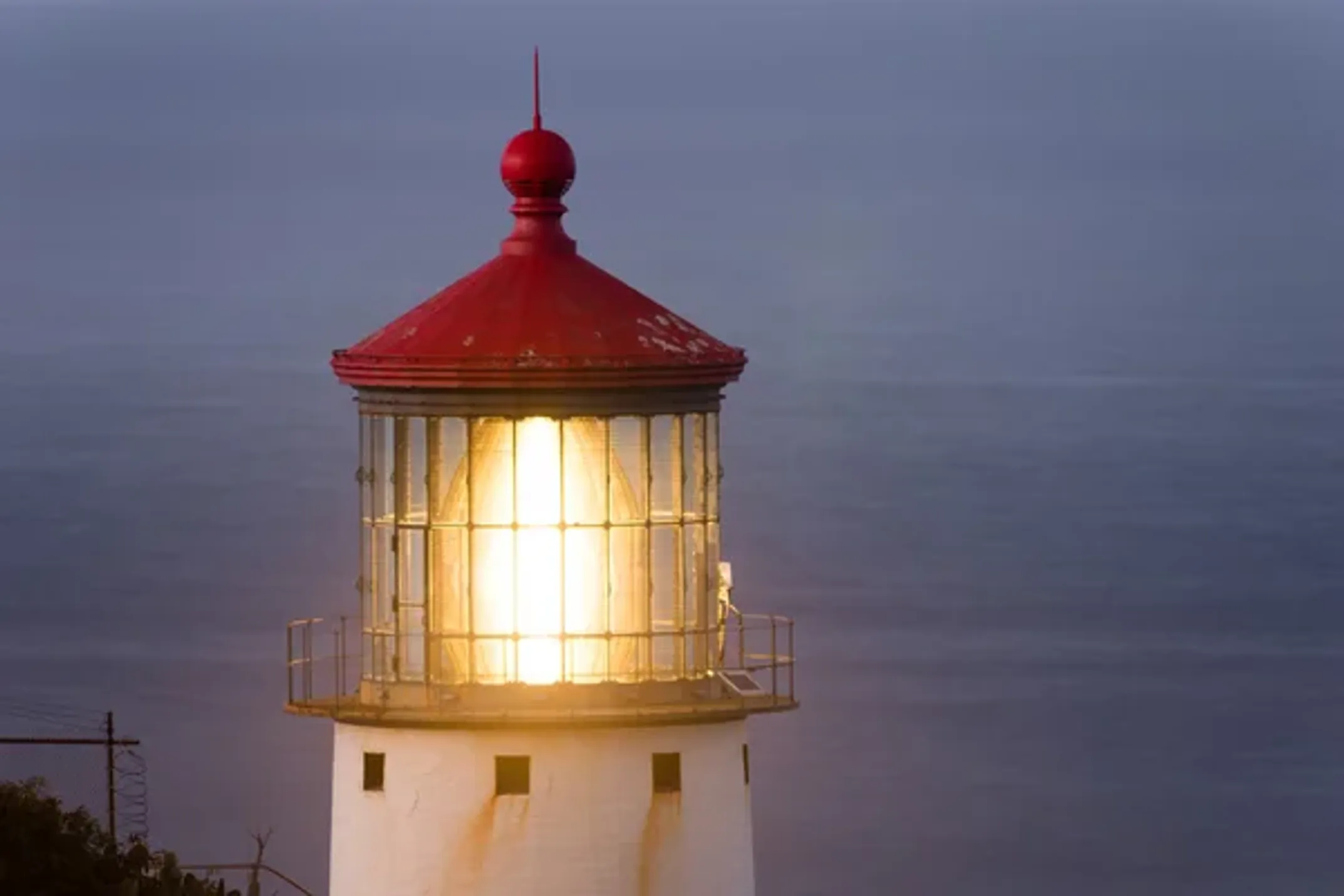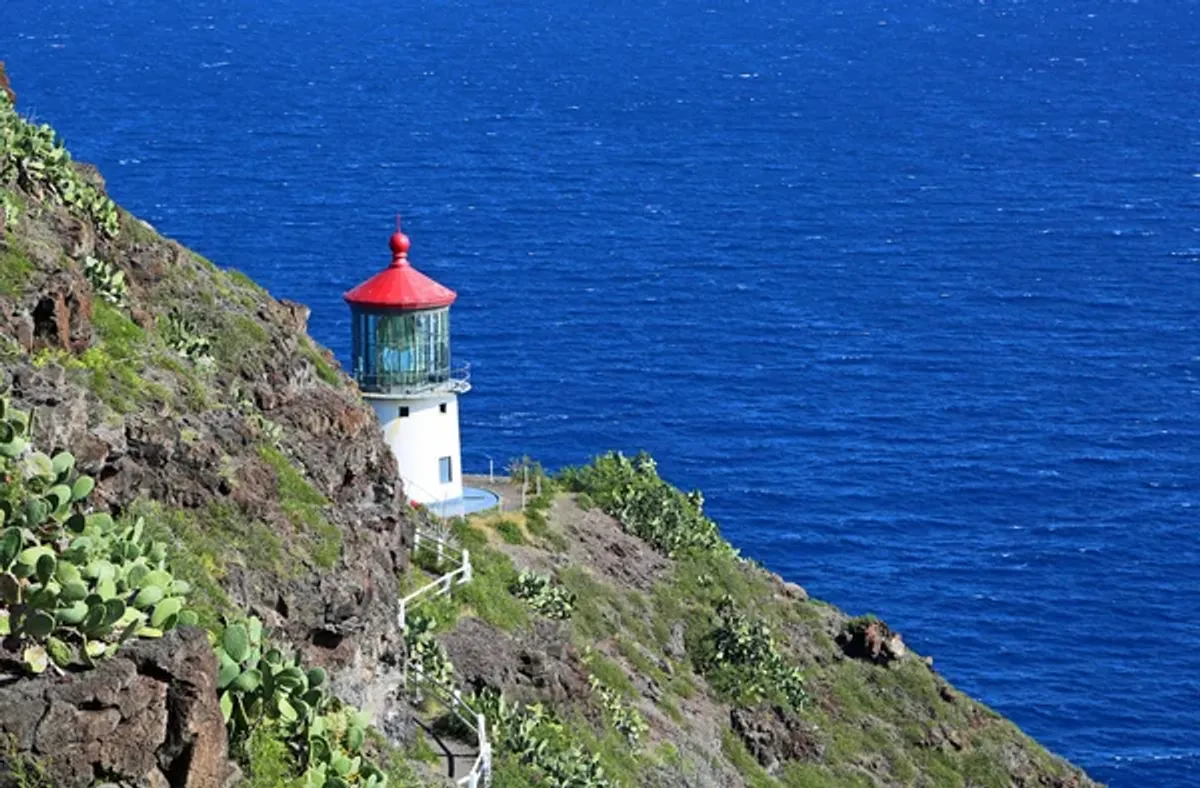

The Lighthouse & Its Incredible Story
Engineering Marvel, Maritime History & Human Drama

Written by a Local Expert
Leilani AkoThe Star Attraction: Makapu'u Lighthouse
The red-roofed lighthouse perched on the 600-foot cliff isn't just photogenic—it's a piece of maritime history with an incredible story that spans over a century of Hawaiian coastal navigation.
Why This Lighthouse Exists
The need became clear after several ships ran aground on the reefs. The most notable was the steamer Manchuria, which grounded off Waimanalo in August 1906, highlighting the treacherous nature of this coastline. Earlier incidents included the S.N. Castle running aground, leading to petitions for navigational aid as early as 1888.
The lighthouse first lit up on October 1, 1909, and has guided ships safely past this treacherous coast ever since. Its construction represented a significant federal investment in Hawaiian maritime safety during the territorial period. The project faced numerous challenges, from transporting materials to this remote location to installing complex equipment on sheer cliffs.
When the powerful new light first activated in 1909, it confused the crew of the Japanese cruiser Izumo approaching from the east. The uncharted beacon prompted them to halt offshore until daylight, demonstrating the light's impressive range and power even in its earliest days of operation.
The Amazing Lens: An Engineering Marvel
What makes Makapu'u special is its massive Fresnel lens—the largest ever used in an American lighthouse. This engineering marvel stands 12 feet tall with over 1,000 precisely arranged prisms. The lens was built in Paris in 1887 by Barbier & Cie for $15,280 and displayed at the 1893 Chicago World's Fair and 1907 Jamestown Exhibition before making its way to this remote Hawaiian cliff.
🔬 Technical Specifications
- Height: 12 feet tall
- Prisms: Over 1,000 pieces
- Design: Hyper-radial Fresnel
- Size Classification: "Off the chart"
🏭 Manufacturing History
- Made: Paris, 1887
- Cost: $15,280 (1887)
- Displayed: 1893 World's Fair
- Journey: Via Jamestown Exhibition

The lens represents the pinnacle of 19th-century optical engineering. Its hyper-radial design was considered "off the chart" in size, larger than any Fresnel lens previously manufactured. The interior space is large enough for several people to stand inside, demonstrating the massive scale of this optical instrument.
Installing the lens required hoisting heavy glass pieces up the sheer cliff face from ships below, then carefully reassembling them in the tower. This process took months and required specialized rigging and exceptional skill from the installation crew. Each prism had to be positioned with mathematical precision to achieve the lens's focusing power.
How the Light Worked
The lighthouse originally operated with a 1,000-watt bulb, but its distinctive flashing pattern came from copper panels revolving on tracks between the light source and lens. A weight-driven mechanism powered this rotation, requiring winding every three and a half hours during the era of manned operation.
⚠️ Damage & Restoration
In 1968, a vandal damaged the lens with a bullet, shattering two irreplaceable "belt" lenses. Despite this damage, the lens continues operating today. The Keer Glass Foundry later machined replacement components, noted as the largest such elements ever created for any lighthouse worldwide.
🏮 Lighthouse Facts
- First Lit: Oct 1, 1909
- Height: 600 feet above sea
- Lens Size: 12 feet tall
- Automated: 1974
- Maintained by: US Coast Guard
📅 Historical Timeline
- 1888: First petitions for aid
- 1906: Steamer Manchuria grounds
- 1909: Lighthouse first lit
- 1968: Lens damaged by vandal
- 1974: Automated operation
💎 The Fresnel Lens
- Largest in American lighthouse
- Made in Paris by Barbier & Cie
- Displayed at 1893 World's Fair
- Over 1,000 glass prisms
- Hyper-radial design
📖 Continue Reading
Lighthouse Keepers' Stories and Human Drama
The human stories from the lighthouse era add profound depth to your visit. These men and their families faced isolation, harsh weather, and the constant responsibility of maintaining the light that meant life or death for passing ships.
The Tragic Story of Alexander Toomey
First Assistant Keeper Alexander Toomey died tragically in 1925 from severe burns sustained during an alcohol explosion within the lighthouse tower. His reported last words to his wife were "Stand by the light and keep it burning."
His pregnant wife died shortly after giving birth just months later, adding to this chapter's profound sadness. This story reminds us of the human sacrifice behind the lighthouse's steady beacon.
Life at the Lighthouse
The keepers lived in quarters built from local blue lava rock, demolished in 1987 though remnants remain visible near the summit. The isolated lifestyle required complete self-sufficiency and unwavering dedication to maintaining the light that ships depended upon for safe passage.
Daily Duties
Winding the weight-driven mechanism every 3.5 hours, cleaning the massive lens, and maintaining the light no matter what weather conditions prevailed.
Isolation Challenges
Living on a remote cliff with limited contact to the outside world, keepers and their families had to be entirely self-reliant for everything from medical care to entertainment.
Sacred Responsibility
The lighthouse beam was literally a matter of life and death for mariners navigating the treacherous waters around Oahu's southeastern coast.
End of an Era
The lighthouse was automated in 1974, ending the era of resident keepers and their families. Today, the United States Coast Guard maintains this historic beacon using modern technology while preserving its historical character and that magnificent Fresnel lens.
Standing at Makapu'u Point today, you're not just looking at a lighthouse—you're witnessing a testament to human ingenuity, sacrifice, and dedication. The beacon that continues to guide ships through Hawaiian waters carries with it over a century of stories, from engineering triumphs to personal tragedies, all in service of maritime safety.
